Agent-Based Models of a Banking Network as an Example of a Turbulent Environment:
The Deliberate vs. Emergent Strategy Debate Revisited
Duncan A. Robertson
Loughborough University, ENG
Introduction
Few agent-based models have as yet made their way into the mainstream of management literature. This article sets out to introduce an agent-based model for studying different strategies available to banks. A model is structured that can be developed in order to give new insight into management debates, and that can give insight into the most appropriate strategies under differing environmental conditions. By using agent-based models of strategy at an abstract level, some insight can be gained to distinguish between strategies that may be appropriate and that warrant further empirical investigation, and those that do not.
An agent-based model is introduced that can be used to study strategies from a bank's perspective. It contains a network of banks and customers, where customers and banks are boundedly rational and turbulence is present within the banking environment. Banks can decide the extent to which they operate in several strategic dimensions. Strategic reviews cause a change in the positioning of the banks, which in turn causes a redistribution of their customers to competitors, which in turn feeds back to influence banks' future strategic analysis and subsequent movement. By using an agent-based model, insights can be gained into a nonlinear world, such insights not being provided by conventional linear strategic analyses.
First, the strategic management literature specific to the banking sector is reviewed. Next, the strategic groups literature is reviewed, and from it is borrowed the concept of banks being positioned within a strategy space. This is extended this to an n-dimensional space that can be thought of as a “strategy hypercube.”1 Banks are located at different positions within this space. In order to understand the dynamics of how a firm moves within this space, the differences between “deliberate” (planned) strategies and “emergent” (learning) strategies are discussed. The concept of environmental turbulence is reviewed, the extent of which will influence the most appropriate strategy. Finally, the rationale for using agent-based models is discussed, and a simple simulation is introduced that can capture these aspects of strategy.
BANKING STRATEGY
Heffernan (1996: 310-28) sets out some of the strategic, as opposed to financial/economic, issues that are relevant to banks. As Heffernan puts the problem:
One of the key questions that bank managers need to ask themselves is this: is there a coherent strategy a bank can adopt which will achieve the joint objectives of maximizing profitability, shareholder value added, and survival in the marketplace?
While the study of banks and their role as intermediaries has been widely discussed within the realms of economics and finance, there has been remarkably little analysis of banks within the main strategic management journals. Exceptions include analyses of the founding rates of Italian banks from a population ecology perspective (Lomi, 1995); the effects of environmental uncertainty of decision processes (Leblebici & Salancik, 1981); competition, learning, and strategy in Tokyo Banking as a niche entry decision (Greve, 2000); followers' entry decisions (Fuentelsaz et al., 2002); and an evolutionary model of organizational performance (Barnett et al., 1994).
STRATEGIC DIMENSIONS FOR BANKING: STRATEGIC GROUPS
Strategic groups are defined as groups of firms that follow similar strategies with regard to one or more strategic dimensions (Hunt, 1972; Porter, 1979). Whereas strategic group analysis is usually focused on the positioning and clustering of firms on these strategic dimensions, little research has been carried out on the dynamics of the firms within these strategic dimensions, although more recent literature such as Lee et al. (2002) has modeled the dynamics of the emergence of strategic groups by using a genetic algorithm-based approach.
The strategic group framework is used merely to identify strategic dimensions for the banking industry. From this, an abstract space can be generated that can be used as a basis to locate banks' strategies (i.e., their position and movement in position within this space). In the simplest form of this model, it is assumed that banks are not restricted to the positions that they can occupy. For instance, there are no exogenous “mobility barriers” that are industry dependent: The bank is allowed to take any position within the strategy space.
While this strategic groups analysis usually takes place on a limited number of dimensions, this analysis may be extended to an arbitrary number of dimensions, and a firm can be considered to occupy a position within this n-dimensional strategic space—a space that I shall refer to as a “strategy hypercube.”
Generic strategic dimensions produced using the strategic groups methodology (McGee & Thomas, 1986) include:
- Product lines (degree of product diversification/differentiation).
- Degree of vertical integration.
- Investment behavior.
- Relative size of firm (leader/follower classification).
- Manufacturing, marketing, and financial variables.
- Dimensions of firms' strategic posture.
Research on strategic groups within the banking industry provides justification for strategic dimensions that are particularly important in the banking industry. For example, Amel and Rhoades (1987: 31, 1988) use the following products from balance sheet analyses to locate the positioning and hence determine strategic dimensions of US banks: US Treasury securities; state and local government securities; real estate loans; construction loans; farm loans; residential loans; multifamily nonfarm loans; commercial and industrial loans; loans to individuals; federal funds bought; individual, partnership, and corporation (IPC) deposits; US government deposits; non-transactions account savings deposits; and time deposits.
Other authors, such as Hackethal (2001) and Mehra (1996), have indicated other important dimensions, such as considering both market-based view variables and resource-based view variables.
The same strategic dimensions of the strategy hypercube can be used in order to position the value-generating assets, the capture of which by banks gives rise to sustainable competitive advantage. In the simplest form of the model, these can be considered to be customers of banks: The greater the number of customers, the greater a bank's profitability, which in turn gives rise to competitive advantage. Both the banks and the value-generating agents (customers) are located in the same space. While the strategic dimensions of value-generating agents and banks may differ, they can coincide in Lancaster's (1966) “product characteristics space.” If value-generating agents are restricted to being customers, product characteristics space can be used as a specific example of strategy space. It is further assumed in this model that the dimensions used are orthogonal; if the dimensions are nonorthogonal, the topology of strategy space will change from being an unrestricted space to being a “surface,” and agents' movements would have to be confined to trajectories on such a surface.
EMERGENT VS. DELIBERATE DEBATE: LEARNING
Early models of strategy, for example Porter's (1980) “five forces” model, consider the environment of a firm to be essentially static. These conform to Chandler's (1962) definition of strategy:
the determination of the basic long-term goals and objectives of an enterprise, and the adoption of courses of action and the allocation of resources necessary for carrying out these goals.
Little emphasis is placed on the dynamics of strategy.
Later works have emphasized learning as an important factor in strategic management. In a response to earlier work on “disjointed incrementalism” (Braybrooke & Lindblom, 1963), Quinn (1978, 1980) introduced the concept of “logical incrementalism” to explain why planning did not describe the actual strategies adopted by managers:
When well-managed major organizations make significant changes in strategy, the approaches they use frequently bear little resemblance to the rational, analytical systems so often described in the planning literature. (Quinn, 1980)
Mintzberg (1994: 24-5) differentiates between “deliberate” strategies, where “intentions [are] fully realized” and “emergent” strategies, “where a realized pattern was not expressly intended.” Limitations to managers' abilities are introduced by Simon's (1947, 1957) concept of “bounded rationality” whereby agents, due to the uncertainty of the future and costs of acquiring information, act in a way that is not completely rational. Managers have different schemata, and will also have different causal maps or mental models (Huff, 1990) that will influence their individual decision making and therefore the ensuing strategy of the firm.
Chaffee (1985) confirms that one of the objects of strategy is to deal with changing environments, and agrees that strategy is multidimensional. Chaffee divides strategy into three models: linear, adaptive, and interpretive. Chaffee notes that the linear model of strategy involves varying the organization's links with the environment (by changing its products or markets or by performing other entrepreneurial actions). The adaptive model differs from the linear model in that monitoring the environment and making changes are simultaneous and continuous. Chaffee notes that this mode is more applicable to an environment that is less susceptible to prediction and is more dynamic. Finally, Chaffee's interpretative model relies heavily on metaphor being used to guide managers, much in the way that complexity reasoning has largely hitherto influenced management.
TURBULENCE
Few concrete definitions of turbulence exist within the management literature, even though it is a term that is often cited. Chakravarthy (1997: 69) notes that
complexity is a measure of the number of competitive configurations that a firm must ideally consider in shaping its strategy. The dynamic of the environment, i.e. the rate at which these configurations change over time is the other key determinant of turbulence.
Existing frameworks for analyzing strategy have not proved useful for understanding why firms build competitive advantage in times of rapid change (Teece et al., 1997). Authors such as D'Aveni and Gunther (1994) have viewed certain sectors of the business environment, including banking, as “hypercompetitive,” while Kelly and Allison (1999) have reviewed banking strategy within Citibank, citing its use of tools based in complexity theory.
If the business world is viewed as being complex, it is inappropriate to consider models developed under paradigms of equilibrium, stability, and linearity to produce an analysis of a turbulent environment. Just as nonlinear mathematics is required when studying turbulence within engineering, we too must adopt models and tools that capture the nonlinearity of a firm's environment. In this model, it is assumed that the dimensionality of the strategy space remains constant; Péli and Nooteboom (1999) provide an overview of the effects of changing dimensionality.
CEOs from other industries have indicated the attractiveness of a turbulent environment should they have “dynamic capabilities” (Teece et al., 1997):
the only advantage Intel has is that we have been faster to get to some places than other people have. That implies we have places to go. If I don't have places to go, I lose time as a competitive advantage. So give me a turbulent world as compared with a stable world and I'll want the turbulent world. (Karlgaard & Gilder, 1996: 63, cited in Lee et al., 2002, italics added)
In this simple model, turbulence is considered to result from changes in the links with value-generating agents; however, this may be extended to include changes in the strength of interaction between banks and value-generating agents, or by the rapid introduction and removal of new agents from the strategy space. Chakravarthy (1997) cites falling entry and mobility barriers and increasing returns to scale as contributing to turbulence. Furthermore, Chakravarthy suggests several strategies for coping with turbulence, including “repeat first mover advantages,” “maintaining network effects,” “going with the flow.” At least at a conceptual level, these can be investigated by the use of agent-based models.
RATIONALE FOR USING AGENT-BASED MODELS
The use of simulations and agent-based models is a new field for strategic management, although they are becoming more widely used within other social sciences (Axelrod, 1997; Epstein & Axtell, 1996; Gilbert & Troitzsch, 1999). Simulations of banks using agent-based toolkits do exist, but not in a strategic management context. Askenazi (1997) introduced the BankNet model using Swarm2 merely in order to demonstrate some of the graphical elements of the Swarm libraries. However, this model was developed in an economic context, to study banking intermediation (Sapienza, 2000). Robertson (2003) describes the use of agent-based models in management research, while Richardson (2003) notes some of the limitations of using such a “bottom-up” modeling technique.
As such models are largely developed from an economic perspective, they focus on the market rather than the individual firm. The goal of any simulation within the strategic management forum should be to aid in determining optimal strategic decisions from the point of view of individual firms. This article intends to develop a model of banking as a tool to inform the debate within the strategic management arena. It should be noted that it does not purport to be an economic analysis of banking in general or of a banking market in particular. The Askenazi/Sapienza BankNet model studies the banking system by positing a system whereby
economic agents work in a framework where operations of deposit and credit continually take place, in an environment characterized by great variance of the optimal capital and of cash flows for each agent (heterogeneity), imperfect information, which leads to positive transaction costs and limited exchanging opportunities. (Sapienza, 2000: 165)
While these models are interesting from the point of view of exploiting some of the graphical elements of the Swarm libraries, or as another way of analyzing the economic emergence of banks as intermediaries, they do not enable us to glean information on banks' most appropriate strategies.
A MODEL FOR BANKING STRATEGY WITHIN A TURBULENT ENVIRONMENT
What is distinctive about this model is that there is more than one type of agent: in this case banks and customers, each exhibiting different behaviors.
Chaffee (1985: 89-90) states “a basic premise of thinking about strategy concerns the inseparability of organization and environment … the organization uses strategy to deal with changing environments.” The environment can be thought of as containing sources of competitive advantage (which in this simple version of the model is restricted to being customers, although they may in fact be any source), enabling links between the organization (bank) and its environment (customers). The changing environment (from the firm's perspective) can be seen by the changes in the links it has with the value-generating agents (customers).
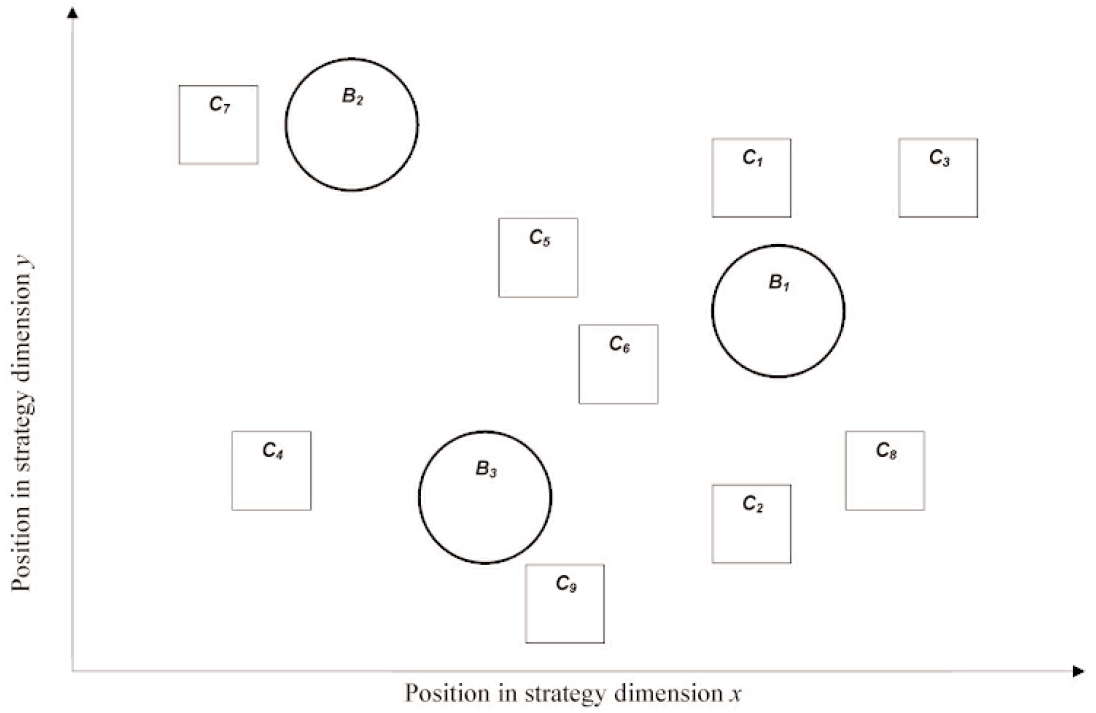
Figure 1 Location of banks (B) and customers (C) in the strategy hypercube.
The discipline of strategic management, being a subject that builds on several parent disciplines such as economics, sociology, and psychology, does not have the advantage of other disciplines that allow the development of existing models. Agent-based models may be a way of reducing this difficulty. A level of rigor can be introduced, allowing models to be built on and altered to fit the level of abstraction required for a different industry, or a different strategic problem.
This model uses a strategy space similar to that used in strategic groups as described above. In this representation of strategy as an n-dimensional “strategy hypercube,” the firm has a set of coordinates that describe its strategy. To aid interpretation, although the space is n-dimensional, the description in this article is simplified by representing only two of the n dimensions.
A population of firms and customers is distributed in the strategy space (see Figure 1). Value-generating agents (in this simple version of the model these can be considered to be customers) are also positioned in the same space. For the moment, customers can be considered to have a set of requirements that determine their position in the strategy space. Similarly, banks are positioned according to the strategies they adopt (although their strategy is more than their static position; it also encompasses the movement within this space).
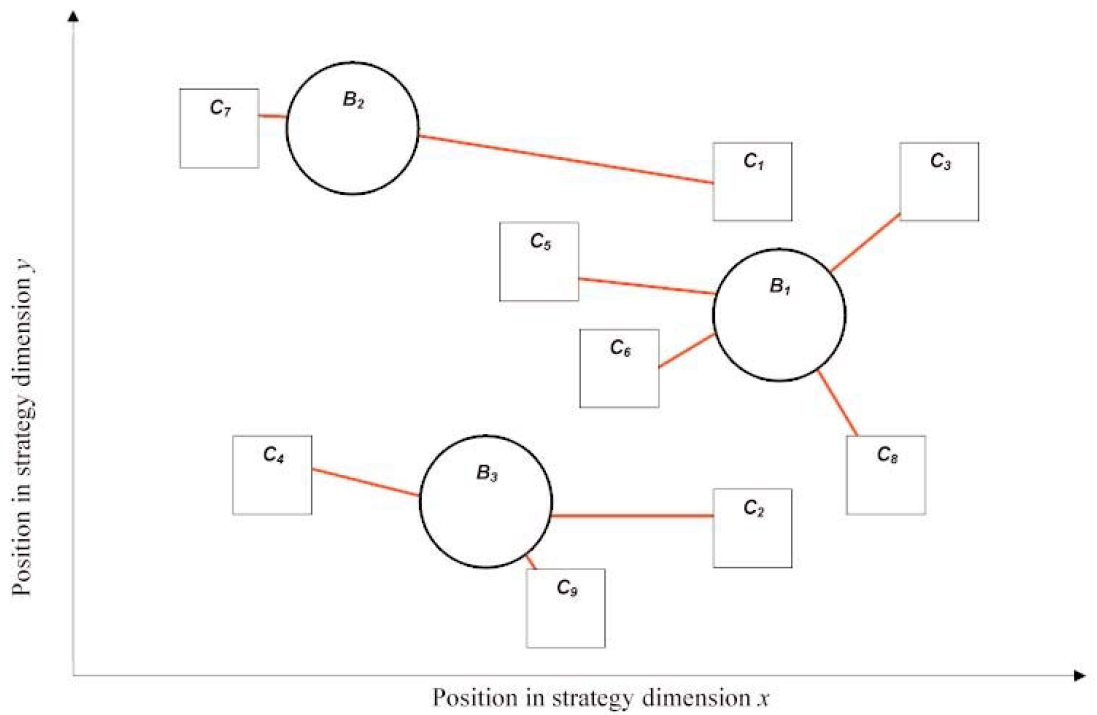
Figure 2 Formation of links between banks and customers
Customers set up relationships with banks according to the proximity of the banks' strategic positioning in relation to the customer's strategic requirements (customers select banks closest to them in strategy space). Customers are not, however, perfectly rational: They may decide to bank with a firm that is not closest to them, as long as this meets a minimum (“cut-off”) satisfaction level. This incorporates Herbert Simon's notions of bounded rationality and satisficing (for example, in Figure 2 customer agent C1 has a relationship with bank B2, whereas if the customer was exhibiting purely rational behavior they should be linked with bank B1).
PARAMETERIZATION OF THE MODEL
In addition to the (x, y, …) coordinates of the customers and the banks, the following parameters are associated with the customer and bank agents.
CUSTOMERS
Customers have a satisfaction level, s, associated with the distance between the customer and the bank (using Euclidean geometry to calculate this distance, so that this calculation can be extended to n dimensions). A representation of the calculation of s is shown in Figure 3. The introduction of a minimum cut-off satisfaction level where customers search for a new bank indicates that the customers are only boundedly rational.
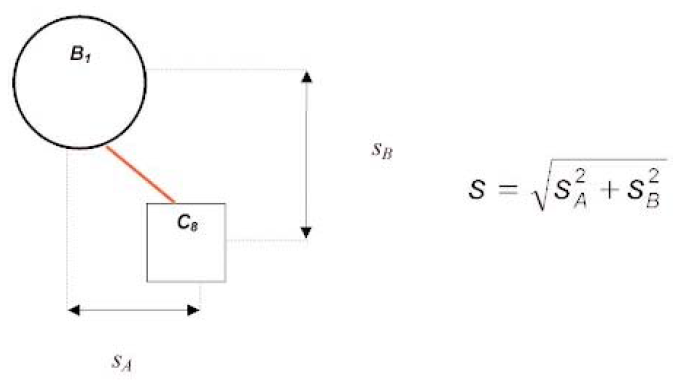
Figure 3 Measurement of satisfaction level, s
Customers' satisfaction levels (which are assumed to be proportional to the distance between their position in strategy space and the location of the bank with which they have a relationship) are compared at discrete time intervals with their minimum tolerated (cut-off) satisfaction level. If the distance between the customer and their bank is less than their cutoff satisfaction level, they do not change banks; otherwise they search for a bank that more closely matches their needs.3 This introduces a notion of “customer inertia” into the model.
When they are unsatisfied, customers will look for a bank that closely matches their requirements. It is assumed that if the customers become dissatisfied, they will link to the bank that is closest to their position.
BANKS
As this simulation is primarily interested in the strategies of banks, this is where most emphasis is placed in the design of the model. Banks occupy a position within the strategy space and derive competitiveness dependent on their location in this strategy space, the level of competitiveness being influenced by the location of their competitors. In this simple model, it is assumed that the only source of competitive advantage is derived from holding and maintaining relationships with valuegenerating agents (in this case, customers generating profits for the bank). In the results of this model, it is assumed that other banks in the industry are stationary, and that the bank that is “controlled” has three strategies open to it: stay still, follow the lead bank, or move to the “center of mass” of its customers.
TURBULENCE
In order to introduce a level of turbulence into the model, it is assumed that customers either stay still (in a nonturbulent environment) or take a random walk in space (in a turbulent environment). Figure 4 shows an indicative output from the running model. The lighter links between banks and customers show satisfied customers; the darker links show dissatisfied customers.
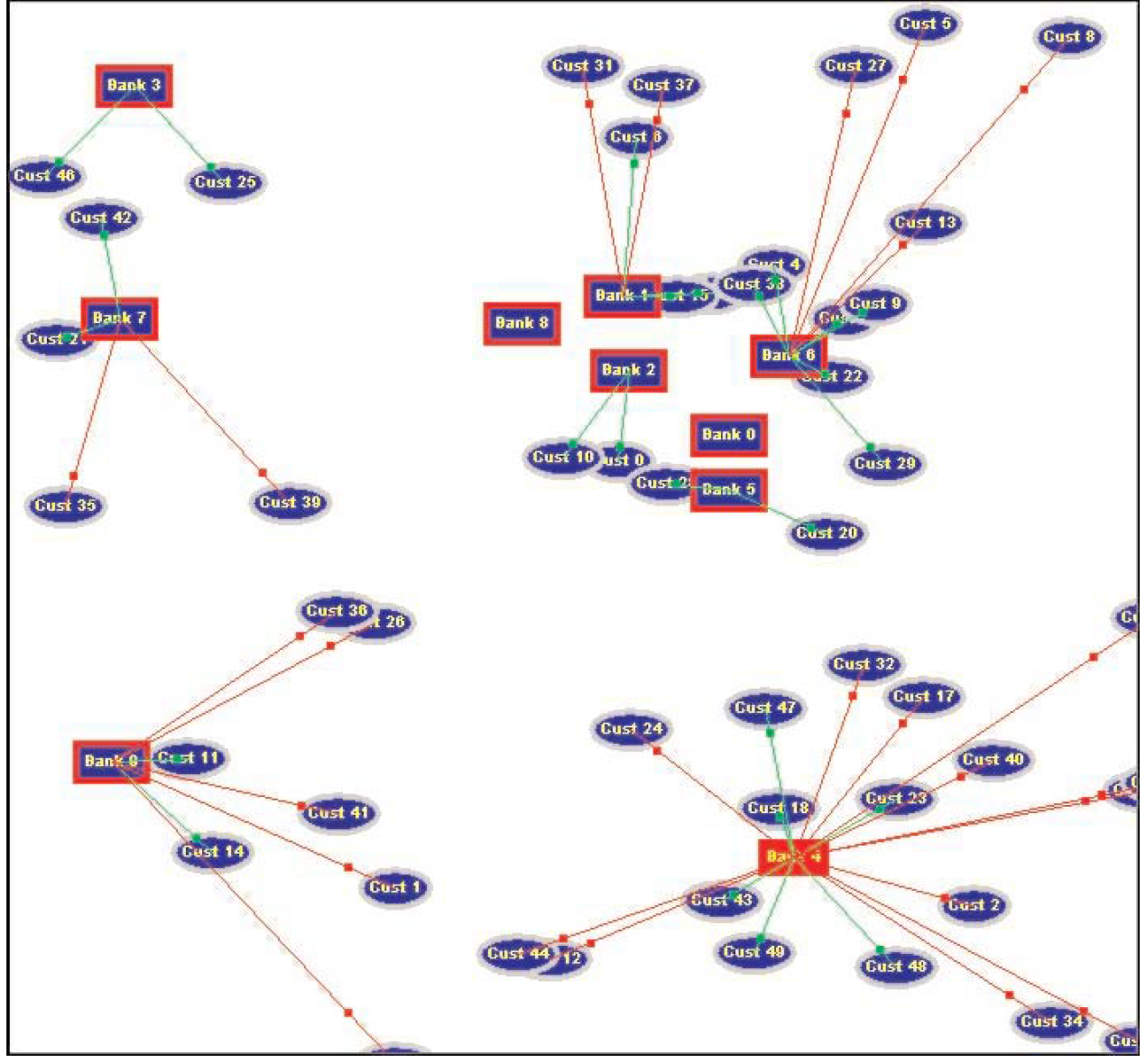
Figure 4 The running model.
RESULTS FROM THE AGENT-BASED MODEL
The results from an agent-based model may be used to inform debate within the management literature, or to suggest areas that may be worthy of empirical research using “real-world” data. Initial results from this model are set out below.
In the figures below, the relationship between turbulence and the cutoff satisfaction level of customers is investigated. The test bank, Bank 0, can adopt any of the following strategies: staying still, following the leader, or a customer-centric strategy. The first strategy (“stay still”) reflects a deliberate strategy on the part of the banks; the latter strategies (“follow the leader” and “customer-centric”) represent more “emergent” (Mintzberg, 1994) strategies, the positioning of banks being influenced from learning about their environment.
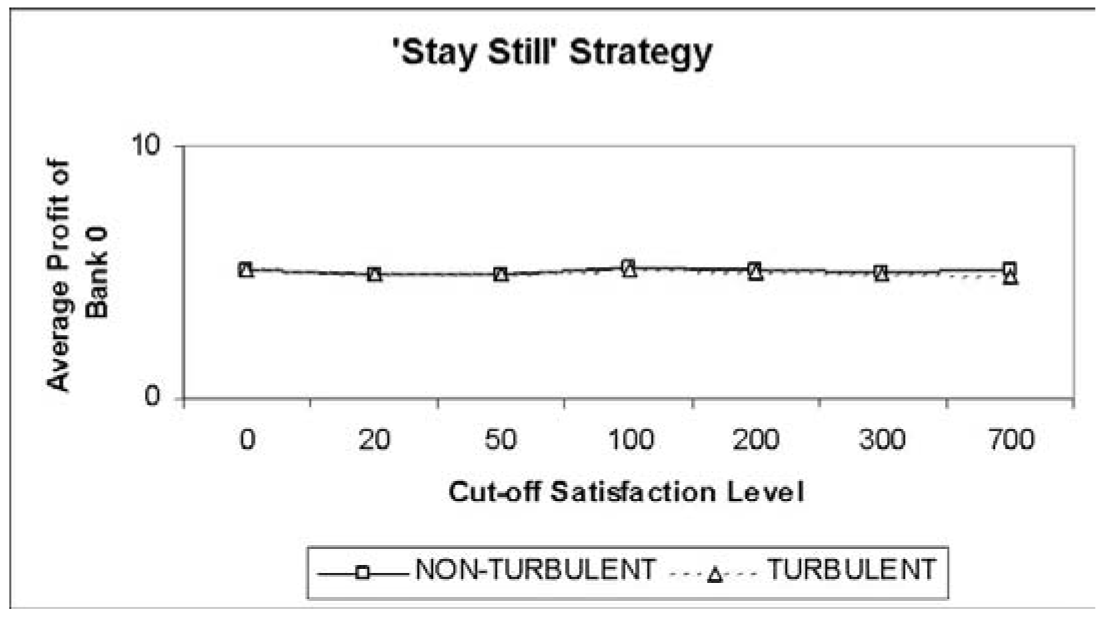
Figure 5 “Stay still” strategy
The results of the “stay still” strategy, which can be thought of as a “control run,” suggest that there is little effect of customers' cut-off level of satisfaction: On average, the customers are likely to be distributed evenly among banks, and in such an environment there is little benefit from adopting such a “stay still” strategy. This in itself is useful, as it confirms the outcome that one would expect from such a configuration.
Results from the model that cannot be predicted intuitively are now discussed. Figures 6 and 7 show the results from the “follow the leader” and the “customer-centric” strategies.
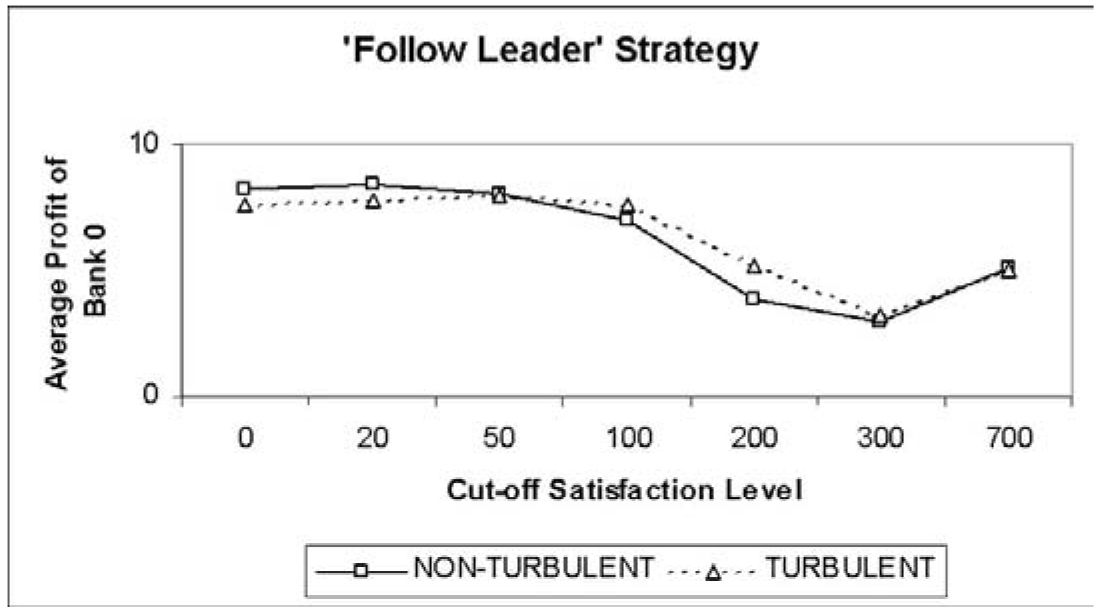
Figure 6 “Follow the leader” strategy
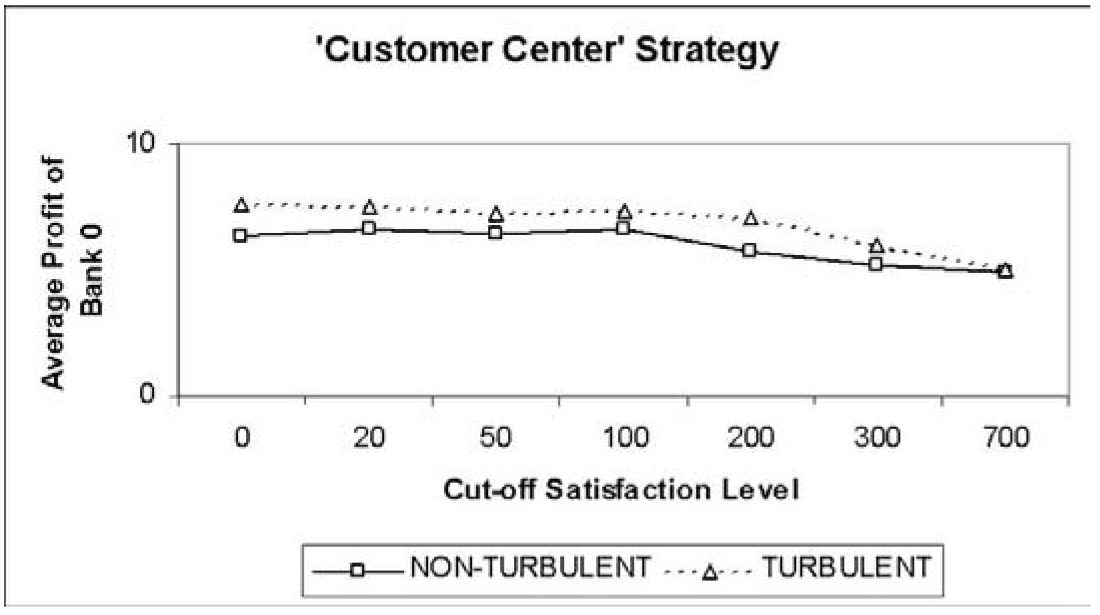
Figure 7 “Customer-centric” strategy
When the test bank adopts the strategy of following the lead bank, the efficacy of such a strategy is dependent on the cut-off level of satisfaction of the customers. For example, if this is zero (i.e., all customers behave “rationally” and form links with their nearest bank), higher profits are likely to be achieved by this strategy compared to adopting a “stay still” strategy. Conversely, when there are moderate cut-off levels of satisfaction, such a strategy may not be beneficial as lower profits are achieved under this strategy as compared to the “stay still” strategy. When there is a very high cut-off level of satisfaction, customers are unlikely to switch (almost regardless of the distance between them and their bank) and the “stay still” level of profits is achieved.
Under a customer-centric strategy, however, the model suggests that there is a benefit from adopting such a strategy when there is a turbulent environment (i.e., there is a likelihood of greater profits resulting from following this strategy in a turbulent environment as opposed to a nonturbulent environment).
Such simulation results can drive hypotheses that such general results may occur in the “real world” and can drive empirical research to test whether adopting such a strategy under such conditions does indeed produce this outcome.
EXTENSIONS TO THE MODEL
The aim of this article is to introduce a simple agent-based model that shows interesting behavior without being so complex that the dynamics of the model are confused. However, if researchers choose to extend this model in order to produce one that is closer to the actual strategies developed by banks, this could be achieved by myriad extensions, such as allowing different levels of profit to accrue from different customers or investigating the effects of differing numbers of banks.
CONCLUSION
Results are presented here from only one particular aspect of this model. This technique can be used to investigate other phenomena by changing model assumptions. The aim of this article is to introduce an actual agent-based model to the field of strategic management and to discuss the reasons why it is an appropriate methodological tool to analyze firms who are in a nonlinear, turbulent environment.
By using agent-based models as outlined above, it is hoped that the debate within the strategic management literature may be influenced to move beyond Chaffee's interpretative mode of strategy and, following Fuller and Moran's (2000) call, “move beyond metaphor.”
NOTES
- A hypercube is “the analogue in space of [n=] four or more dimensions of [a cube] in ordinary three-dimensional space (Oxford English Dictionary). I define a “strategy hypercube” as being an n-dimensional strategy space, the location and movement of a firm within this space describing that firm's strategy. As the dimensions used in strategy are constrained (i.e., they are assumed to have maximum and minimum values), we refer to the “strategy hypercube” as opposed to the “strategy n-space.”
- Swarm is a software package for multi-agent simulation of complex systems.
- Research into switching behavior (Department of Trade and Industry, 2000) shows that, in the UK, current and savings accounts exhibit the lowest level of switching behavior, when compared to a total of nine consumer markets. The results from the research on current accounts shows that only 6 percent of consumers switched their supplier of current account in the last five years, with 15 percent of respondents considering switching, and the remaining 79 percent of respondents not switching or considering switching.
References
Amel, D. & Rhoades, S. (1987) “Strategic groups in banking,” Working Papers in Banking, Finance, and Microeconomics, Number 87-1, Washington DC: Board of Governors of the Federal Reserve System.
Amel, D. & Rhoades, S. (1988) “Strategic groups in banking,” Review of Economics and Statistics, 70(4): 685-9
Askenazi, M. (1997) “Some notes on the BankNet model,” Santa Fe, NM: Santa Fe Institute Working Paper.
Axelrod, R. (1997) The Complexity of Cooperation: Agent-Based Models of Competition and Collaboration (Princeton Studies in Complexity), Princeton, NJ: Princeton University Press.
Barnett, W. P, Greve, H. R., & Park, D. Y. (1994) “An evolutionary model of organizational performance,” Strategic Management Journal, 15(special issue): 11-28.
Braybrooke, D. & Lindblom, C. E. (1963) A Strategy of Decision, New York: Free Press.
Chaffee, E. E. (1985) “Three models of strategy,” Academy of Management Review, 10(1): 89-98.
Chakravarthy, B. (1997) “A new strategy framework for coping with turbulence,” Sloan Management Review, 38(2): 69-82.
Chandler, A. D. (1962) Strategy and Structure: Chapters in the History of the Industrial Enterprise, Cambridge, MA: MIT Press.
D'Aveni, R. A. & Gunther, R. (1994) Hyper-competition: Managing the Dynamics of Strategic Maneuvering, New York: Free Press.
Department of Trade and Industry (2000) “Switching suppliers: Consumer affairs report series executive summary number 2,” London: Department of Trade and Industry.
Epstein, J. & Axtell, R. (1996) Growing Artificial Societies: Social Science from the Bottom Up, Cambridge, MA: MIT Press.
Fuentelsaz, L., Gomez, J., & Polo, Y. (2002) “Followers' entry timing: Evidence from the Spanish banking sector after deregulation,” Strategic Management Journal, 23(3): 245-64.
Fuller, T. & Moran, P (2000) “Moving beyond metaphor,” Emergence, 2(1): 50-71.
Gilbert, N. & Troitzsch, K. G. (1999) Simulation for the Social Scientist, Buckingham, UK: Open University Press.
Greve, H. R. (2000) “Marketing niche entry decisions: Competition, learning, and strategy in Tokyo banking, 1894-1936,” Academy of Management Journal, 43(5): 816-36.
Hackethal, A. (2001) “Strategic groups in European commercial banking,” Discussion Paper Series in Economics and Management, Vallendar, Germany: German Economic Association of Business Administration.
Heffernan, S. (1996) Modern Banking in Theory and Practice, Chichester, UK: Wiley.
Huff, A. S. (ed.) (1990) Mapping Strategic Thought, Somerset, NJ: Wiley.
Hunt, M. S. (1972) “Competition in the major home appliance industry, 1960-1970,” doctoral dissertation, Harvard University.
Karlgaard, R. & Gilder, G. (1996) “Talking with Intel's Andy Grove,” Forbes, 26 February: 63.
Kelly, S. & Allison, M. A. (1999) The Complexity Advantage: How the Science of Complexity Can Help Your Business Achieve Peak Performance, New York: McGraw-Hill.
Lancaster, K. J. (1966) “A new approach to consumer theory,” Journal of Political Economy, 74(2): 132-57.
Leblebici, H. & Salancik, G. R. (1981) “Effects of environmental uncertainty on information and decision processes in banks,” Administrative Science Quarterly, 26(4): 578-96.
Lee, J., Lee, K., & Rho, S. (2002) “An evolutionary perspective on strategic group emergence: A genetic algorithm-based model,” Strategic Management Journal, 23(8): 727-46.
Lomi, A. (1995) “The population ecology of organizational founding: Location dependence and unobserved heterogeneity,” Administrative Science Quarterly, 40(1): 111-44.
McGee, J. & Thomas, H. (1986) “Strategic groups: Theory, research and taxonomy,” Strategic Management Journal, 7(2): 141-60.
Mehra, A. (1996) “Resource and market based determinants of performance in the U.S. banking industry,” Strategic Management Journal, 17(4): 307-22.
Mintzberg, H. (1994) The Rise and Fall of Strategic Planning, Hemel Hempstead, UK: Prentice Hall.
Péli, G. & Nooteboom, B. (1999) “Market positioning and the geometry of the resource space,” American Journal of Sociology, 104(4): 1132-53.
Porter, M. E. (1979) “The structure within industries and companies' performance,” Review of Economics and Statistics, 61(2): 214-27.
Porter, M. E. (1980) Competitive Strategy: Techniques for Analyzing Industries and Competitors, New York: Free Press.
Quinn, J. B. (1978) “Strategic change: 'Logical incrementalism,'” Sloan Management Review, 20(1): 7-21.
Quinn, J. B. (1980) Strategies for Change: Logical Incrementalism, Homewood, IL: Irwin.
Richardson, K. A. (2003) “On the limits of bottom-up computer simulation: Towards a nonlinear modeling culture,” Proceedings of the 36th Hawaii International Conference on System Sciences, Big Island, Hawaii, January 6-9.
Robertson, D. A. (2003) “Agent-based models in management research,” paper presented to the Academy of Management Annual Meeting, Seattle.
Sapienza, M. D. (2000) “An experimental approach to the study of banking intermediation: The BankNet simulator,” in F. Luna & B. Stefansson (eds.), Economic Simulations in Swarm: Agent-Based Modelling and Object Oriented Programming, Boston: Kluwer Academic Publishers.
Simon, H. A. (1947) Administrative Behavior, New York: Macmillan.
Simon, H. A. (1957) Administrative Behavior, New York: Macmillan.
Teece, D. J., Pisano, G., & Shuen, A. (1997) “Dynamic capabilities and strategic management,” Strategic Management Journal, 18(7): 509-33.